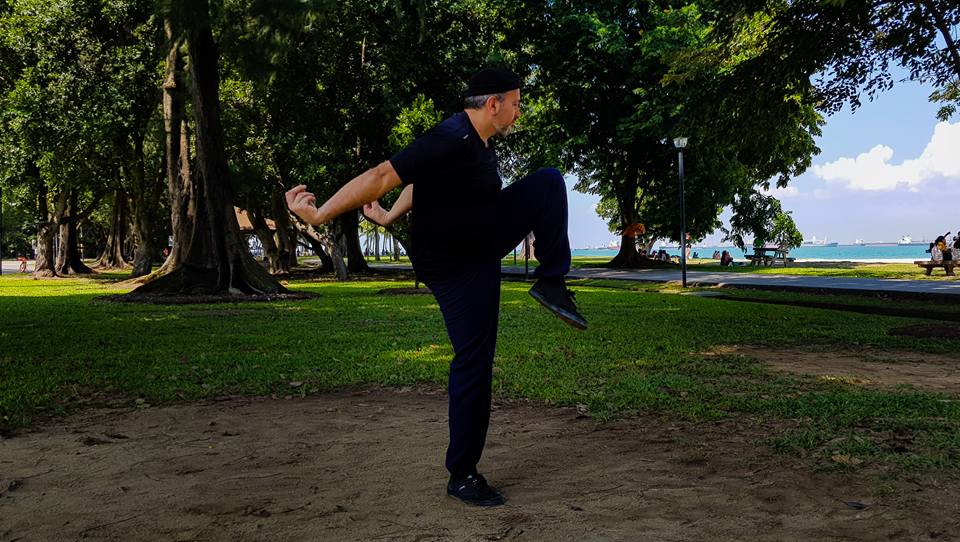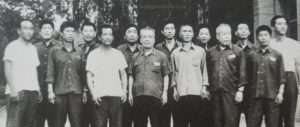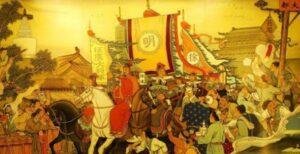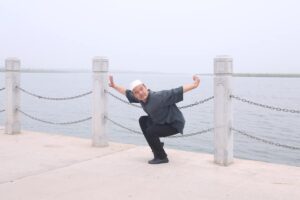“The Theory of Internal and External Five Forms”
The External Five Forms must be harmonious. The Five Elements correspond to the Five Hands and Five Feet:
- Five Hands: Beng (崩), Bo (搏), Zuan (攒), Dai (贷), Na (拿).
- Five Feet: Quan (圈), Dian (点), Cha (查), Bai (摆), Ti (踢).
When performing martial arts, if one does not understand these five hand and foot techniques, they do not truly understand the internal and external forms. The hands and feet each have their own transformations, and their applications are profound.
The Internal Five Forms correspond to the Five Organs: the heart, liver, spleen, lungs, and kidneys. Where the qi (气) and strength (力) go, the posture follows; where the posture goes, the qi and strength are concentrated. Therefore, when qi and strength are abundant, the posture is effective, and when the posture is trained, qi and strength increase. The Five Organs are the foundation of the body. As the saying goes: “The Five Organs are like layers of gates; if they are healthy, they naturally protect the body.”
When beginners start learning martial arts, if they do not know how to circulate qi, the qi remains stagnant in the chest, the body becomes tense, and the limbs lack strength. Over time, this will lead to illness. To learn martial arts, one must also learn how to circulate qi, using methods such as:
- Shoulders relaxed.
- Head upright.
- Teeth lightly clenched.
- Lips closed.
- Tongue pressed against the roof of the mouth.
With prolonged practice, to master the art, one must strengthen the dantian (丹田), cultivate qi in the dantian, and circulate qi to the limbs. When the qi is full and the strength is sufficient, the martial artist achieves unity between internal and external elements.
The Five Elements must be in harmony, with the Five Forms corresponding to the Five Organs, and the Five Organs corresponding to the Five Hands and Five Feet. Therefore, practicing the Five Hands and Five Feet nourishes the Five Organs:
- If the kidneys are strong, the essence (精) is abundant.
- If the heart is strong, the mind is sharp and the spirit is alert.
- If the lungs are strong, the qi is abundant.
- If the liver is strong, the strength is fierce.
- If the spleen is strong, the body is healthy.
Thus, the Five Hands and Five Feet internally nourish the Five Organs, strengthen the brain, protect the dantian, externally strengthen the bones and tendons, make the hands and feet agile, and sharpen the senses. The profundity of this is infinite, and with prolonged practice, one will naturally understand it.
The Five Organs are the heart, liver, spleen, lungs, and kidneys. The Five Elements are metal, wood, water, fire, and earth. The Five Hands are Beng, Na, Zuan, Dai, and Bo. The Five Feet are Quan, Dian, Cha, Bai, and Ti.
- Beng (崩) and Ti (踢) belong to Wood, and their qi originates from the liver. When the joints are agile and strength is used, the liver is relaxed. Practicing Beng (崩拳) and kicking can nourish the liver.
- Na (拿) and Cha (查) belong to Metal, and their qi originates from the lungs. When the tendons of the hands are slightly engaged, the lungs are relaxed. Thus, Na (抓拿) and Cha (查脚) can nourish the lungs.
- Zuan (攒) and Dian (点) belong to Water, and their qi originates from the kidneys. When slightly engaged, they can nourish the kidneys.
- Dai (贷) and Bai (摆) belong to Fire, and their qi originates from the heart. They require the use of blood and strength, thus nourishing the heart.
- Bo (搏) and Quan (圈) belong to Earth, and their qi originates from the spleen. They involve the entire body and can nourish the spleen.
Explanation
1. External Five Forms (外五形):
These refer to the physical techniques of the hands and feet, which are categorized into Five Hands and Five Feet:
- Five Hands:
- Beng (崩): Explosive power, like a sudden burst.
- Bo (搏): Grappling or seizing techniques.
- Zuan (攒): Drilling or twisting movements.
- Dai (贷): Borrowing or redirecting force.
- Na (拿): Capturing or controlling techniques.
- Five Feet:
- Quan (圈): Circular footwork.
- Dian (点): Quick, precise kicks.
- Cha (查): Checking or intercepting movements.
- Bai (摆): Swinging or sweeping kicks.
- Ti (踢): Direct kicking techniques.
These techniques must be practiced in harmony with the body’s natural movements and the principles of the Five Elements.
2. Internal Five Forms (内五形):
These refer to the internal organs and their connection to martial arts:
- Five Organs:
- Heart (心): Governs the spirit and blood.
- Liver (肝): Governs the tendons and stores blood.
- Spleen (脾): Governs digestion and muscle strength.
- Lungs (肺): Governs respiration and qi.
- Kidneys (肾): Governs the bones and stores essence (精).
The health and balance of these organs are essential for martial arts performance. For example:
- A strong heart ensures mental clarity and focus.
- A strong liver ensures agility and flexibility.
- A strong spleen ensures physical strength and endurance.
- Strong lungs ensure proper breathing and qi circulation.
- Strong kidneys ensure vitality and power.
3. Connection to the Five Elements (五行):
The Five Elements (Wood, Fire, Earth, Metal, Water) are used to describe the relationships between the organs, techniques, and movements:
- Wood (木): Associated with the liver and techniques like Beng (崩) and Ti (踢).
- Fire (火): Associated with the heart and techniques like Dai (贷) and Bai (摆).
- Earth (土): Associated with the spleen and techniques like Bo (搏) and Quan (圈).
- Metal (金): Associated with the lungs and techniques like Na (拿) and Cha (查).
- Water (水): Associated with the kidneys and techniques like Zuan (攒) and Dian (点).
4. Practical Application:
- Qi Circulation: Martial artists must learn to circulate qi through the body, starting from the dantian (energy center below the navel) and extending to the limbs.
- Posture and Strength: Proper posture and alignment allow qi and strength to flow naturally, enhancing power and efficiency.
- Health and Longevity: By practicing the Five Hands and Five Feet, martial artists not only improve their combat skills but also nourish their internal organs, promoting overall health and longevity.
5. Philosophical Significance:
- The concept of Internal and External Five Forms reflects the Daoist principle of unity between mind, body, and spirit.
- It emphasizes the importance of balance and harmony in both martial arts and life.
Conclusion
The Internal and External Five Forms theory is a profound framework that connects martial arts techniques to the body’s internal organs and the natural elements. By practicing the Five Hands and Five Feet, martial artists can achieve harmony between their physical movements, internal energy, and mental focus. This holistic approach not only enhances martial arts performance but also promotes health, vitality, and spiritual growth.




